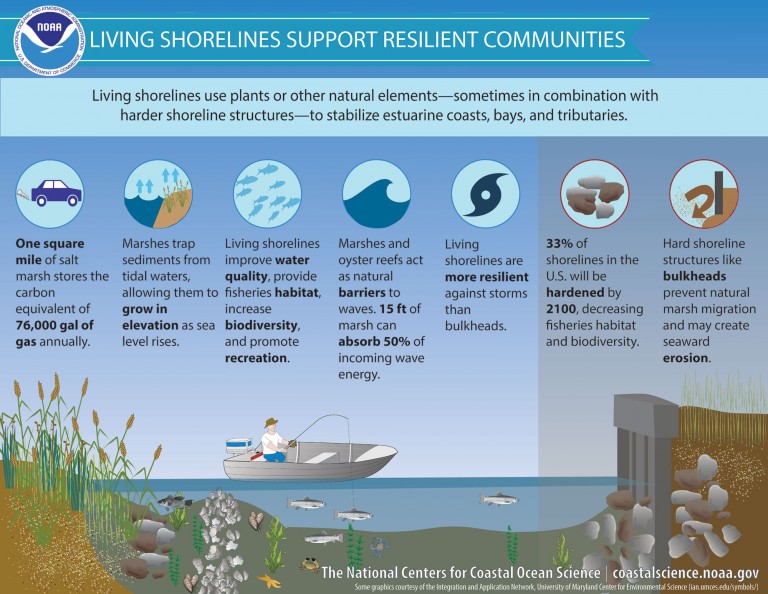
NOAA encourages the use of living shorelines as a stabilization technique along sheltered coasts because they are effective barriers against erosion and provide habitat for coastal species.
What is a living shoreline?
Coastal communities in Florida face constant challenges from shoreline erosion. Although erosion is a natural coastal process, many valuable resources border our state’s coastline. Shorelines need protection from damage caused by intense storms, wave erosion, and sea-level rise.
However, shoreline stabilization does not need to create a barrier between land and water, as happens with hard shoreline stabilization structures like seawalls and bulkheads. New stabilization options, like living shorelines, are gaining attention as an alternative to traditional shoreline stabilization techniques. Living shorelines can reduce damage and erosion while simultaneously providing ecosystem services to society, including food production, nutrient and sediment removal, and water quality improvement.
A living shoreline is “a shoreline management practice that provides erosion control benefits; protects, restores, or enhances natural shoreline habitat; and maintains coastal processes through the strategic placement of plants, stone, sand fill, and other structural organic materials (e.g. biologs, oyster reefs, etc),” according to the
National Oceanic and Atmospheric Administration.

Living Shorelines take a ‘greener’ approach to stabilizing the shore, as seen in the options toward the left of this diagram from the Natural and Structural Measures for Shoreline Stabilization brochure created by the Systems Approach to Geomorphic Engineering (SAGE 2015). Diagram from NOAA Living Shorelines.
Introduction: Living Shorelines as “Greener” Alternatives to “Gray” Approaches
While preservation of natural, living shorelines is a key to environmental health, restoration is sometimes needed to recover shorelines that have been degraded or destroyed. Shorelines are often stabilized with hardened structures, such as concrete seawalls. However, these structures can increase the rate of coastal erosion, remove the ability of the shoreline to carry out natural processes, and provide little habitat for estuarine species. On the contrary, living shorelines are an environmentally friendly, cost-effective method to restore, protect, and stabilize shorelines, waterfront property, and coastal wetlands.
The key living components of Florida’s living shorelines are oyster reefs, mangroves, and salt marshes. The benefits of living shorelines include (taken from www.floridalivingshorelines.com)
- Reduce wave energy and associated shoreline erosion (property loss)
- Reduce storm water flow rates thereby reducing erosion and reducing pollution entering the bay or estuary
- Buffer the effects of storms, especially tropical storms and hurricanes
- Build-up shoreline areas by trapping sediments and stabilizing coastal land
- Ensure natural sediment movement along shorelines
- Improve water quality in our bays and estuaries by filtering pollutants like a living “kidney”
- Provide for shorelines that are resilient to storm damage and sea level rise. A gradually sloping interface between land and sea helps maintain a plant community that can adapt as sea level rises.
- Trap carbon to help reduce the effects of climate change
- Create and connect diverse animal habitats, provide migratory pathways for plants and animals, and support valuable fisheries
- Provide recreational opportunities for humans (e.g., fishing and birdwatching)
- Beautify shorelines
In addition to shoreline protection, living shorelines have economic, ecological, and aesthetic value. Installation of a living shoreline is more cost effective than maintaining or rebuilding seawalls. Living shorelines create, connect, and enhance diversification of animal habitats, and improve water quality by filtering pollutants – like a living “kidney.” These natural shorelines are becoming a pleasant and preferred alternative to man-made structures.
It is important to note that living shorelines should not be placed on already functioning shorelines. However, as shoreline development continues, a living shoreline approach is preferable to hardened seawalls.
Side Effects of a “Gray” Approach
This information can be found at www.floridalivingshorelines.com
Shoreline hardening such as seawalls can alter natural shoreline processes, reduce nursery habitat for marine species and foraging habitat for wading birds, degrades water quality, and can actually increase erosion processes.
- Turn the gradually sloping profile into a right-angle bathtub effect with limited habitat potential.
- Can increase erosion on adjacent property beyond both ends of seawall.
- Are often the shoreline protection option selected to “hold-the-line”.
- Create an abrupt transition from deep water to dry land that eliminates the inter-tidal zone where many marine and estuarine species live.
- Do not provide any filtration of runoff as it transitions from the land into the estuary.
Planning and Implementation
- Site Analysis- As in any restoration project, the anticipated land where the living shoreline will be placed must first be evaluated for factors such as the shore elevation and erosion rate, wave energy, prevailing wind and wave direction, vegetation, and soil type. The design of the project is based on this initial analysis.
- Permit Approval and Legal Compliance- To modify or make changes to any shoreline, you must first obtain a permit. Compliance with all federal, state, and local laws, regulations, and permits for proposed restoration activities must be done prior to implementation. For more detailed information about permitting for living shorelines in Florida, visit: http://floridalivingshorelines.com/information-help-and-documents/permitting/
- Site preparation- Once all necessary permits are obtained, the site is then cleaned of all debris, unstable trees and any failing seawalls that might exist. Issues with runoff should also be addressed prior to material installation.
- Installation- Once your site is prepped, it is time to start installing your living shoreline materials. In Florida, a living shoreline is typically comprised of one of three components: oysters, mangroves and salt marsh grasses. Information on each of these is provided in more detail in the sections below.
- Post construction monitoring and maintenance- In order to verify that a living shorelines is doing its job, it must be monitored to gather information on the success of the project for the purpose of improving the construction and implementation of future efforts. Maintenance activities include debris removal, replanting vegetation, adding additional sand fill, and ensuring that the organic and structural materials remain in place and continue to stabilize the shoreline.
Key Components of Florida’s Living Shorelines
Every living shoreline project is unique and based on the characteristics at the restoration site. Generally, the design for each project is created after an initial assessment of the site. Here, we review some of the most common component used in Florida-based projects, but this list is by no means exhaustive. For a more complete list of the types of living shorelines in Florida, visit: http://floridalivingshorelines.com/types-of-living-shorelines/
Oysters
Eastern oysters (Crassostrea virginica) form extensive intertidal and subtidal reefs in coastal estuaries along the Atlantic coast and Gulf of Mexico. Oyster reefs are currently threatened by coastal urban development, changes in salinity, and destruction by dredging. They are beneficial in providing protection from coastal erosion, water filtration, and habitat for aquatic species.
There are many techniques for restoring oyster reefs, which may be adapted to suit different restoration sites. Large-scale techniques include the deposit of unconsolidated cultch, which is the mass of stones, broken shells, and grit of which an oyster bed is formed, in the subtidal zone or the deployment of concrete structures (e.g. reef balls, stackable forms) parallel to the shore. Small-scale techniques may include building reef structures with wire mesh containers filled with shell, small stackable concrete blocks, oyster bags filled with cultch, or oyster mats. Oyster reefs should be monitored long-term to evaluate the progress and effectiveness of restoration efforts.
Mangroves
Mangrove forests have historically ranged from south Florida to Cedar Key on the Gulf coast and Cape Canaveral on the Atlantic coast, but are now spreading farther north due to warmer winters in recent years. They are highly productive ecosystems that provide habitat for thousands of species, filter runoff, control erosion, and absorb wave energy. Several factors have resulted in the loss of native mangrove forests:
- Conversion of natural lands to agricultural or urban lands
- Using mangrove forests for mosquito control impoundment which involves placing an earthen dike around the area and purposely flooding it during the mosquito breeding season.
- Aquaculture operations
- Introduction of exotic invasive species
It is important to identify the cause of mangrove decline prior to restoration. Removing stressors (e.g. eliminating invasive species or modifying hydrology) may enable natural establishment and recovery of mangrove habitat. When natural recovery is not occurring, it is necessary to harvest propagules or seedlings and transplant at restoration sites. Projects should be monitored for seedling survivability, growth, and leaf canopy to evaluate restoration success.
Salt marsh
In Florida, salt marshes are most abundant on coastlines above the winter freeze line, especially along the “Big Bend” area of the Gulf coast. Salt marshes protect the coastline from storm damage, control erosion of soil, purify water, sequester carbon, and provide important nursery habitat for commercial and recreational fish species. Salt marshes are being degraded and destroyed due to altered hydrology, urban development, pollutants, and exotic invasive species.
Restoration sites should be carefully selected and examined for modified hydrology (dredging or sediment/slope modification), invasive species, and pollutants. Only native plants should be used in restoration and enhancement projects. Plants can be propagated from seed and grown in a marsh grass nursery. Planting considerations include tides, seasons, density, spacing, and substrate. Monitoring of the restoration area should be conducted at roughly the same date each year during the peak of the growing season and at low tide.
Learn More About Living Shorelines in Florida by Region
Florida Living Shorelines has produced an interactive map to learn about existing living shorelines and appropriate plant species in your area, and to find local contacts to assist with design and permitting.
Conclusion
In conclusion, living shorelines have proven to be a more sustainable alternatives to restoration practices such as using seawalls to prevent erosion. Please explore the additional resources below to learn more about this natural approach to coastal restoration.
